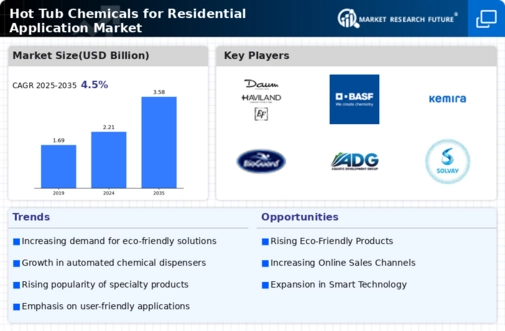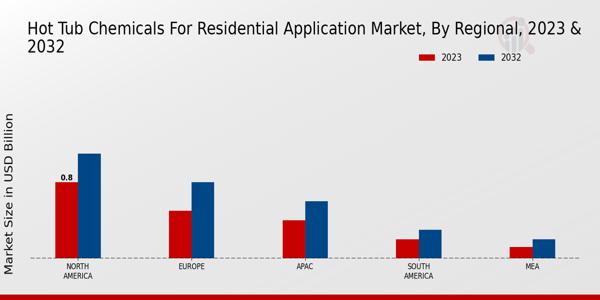Growth of the Wellness Industry
The expansion of the wellness industry is significantly impacting the Global Hot Tub Chemicals for Residential Application Market Industry. As consumers increasingly prioritize mental and physical well-being, hot tubs are viewed as essential wellness tools. This trend is further supported by the rise in home spa experiences, which has led to a greater demand for hot tub chemicals that ensure optimal water conditions. The wellness industry's growth is expected to drive the market, as more individuals invest in home relaxation solutions. This shift in consumer behavior is likely to sustain the market's upward trajectory in the coming years.
Increasing Popularity of Hot Tubs
The rising popularity of hot tubs among homeowners is a primary driver for the Global Hot Tub Chemicals for Residential Application Market Industry. As more individuals seek relaxation and wellness benefits, the demand for hot tubs has surged. This trend is evidenced by the projected market value of 2.21 USD Billion in 2024, which reflects a growing consumer interest in home-based leisure activities. Consequently, the need for effective and safe chemicals to maintain water quality and hygiene in these hot tubs becomes paramount. This increasing consumer base is likely to propel the market further as homeowners prioritize their health and wellness.
Emphasis on Water Quality and Safety
The heightened awareness regarding water quality and safety is a significant factor influencing the Global Hot Tub Chemicals for Residential Application Market Industry. Consumers are increasingly concerned about the potential health risks associated with improperly maintained hot tubs. This concern drives the demand for a variety of chemicals, including sanitizers, pH balancers, and algaecides, to ensure safe and clean water. As the market evolves, manufacturers are likely to innovate and offer advanced chemical solutions that enhance water quality. This focus on safety is expected to contribute to the market's growth, with a projected CAGR of 4.49% from 2025 to 2035.
Technological Advancements in Chemical Formulations
Technological advancements in chemical formulations are reshaping the Global Hot Tub Chemicals for Residential Application Market Industry. Innovations in chemical engineering have led to the development of more effective and environmentally friendly products. For instance, the introduction of biodegradable and non-toxic chemicals is appealing to eco-conscious consumers. These advancements not only improve the efficacy of water treatment but also align with the growing trend towards sustainability. As a result, the market is likely to see an increase in demand for these innovative products, contributing to the projected market value of 3.58 USD Billion by 2035.
Rising Disposable Income and Home Improvement Trends
The increase in disposable income and the trend towards home improvement are key drivers of the Global Hot Tub Chemicals for Residential Application Market Industry. As consumers have more financial resources, they are more inclined to invest in luxury items such as hot tubs. This trend is complemented by a growing interest in enhancing home environments, leading to increased hot tub installations. Consequently, the demand for associated chemicals to maintain these installations is likely to rise. This combination of factors is expected to contribute to a robust market growth trajectory, aligning with the projected market value increase to 3.58 USD Billion by 2035.











